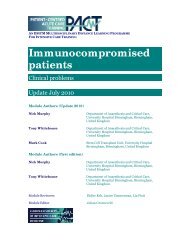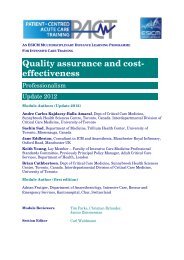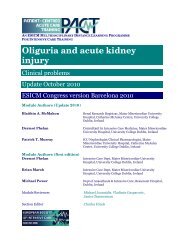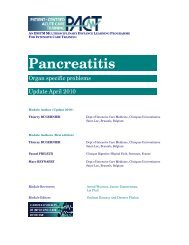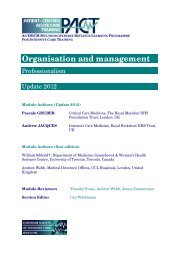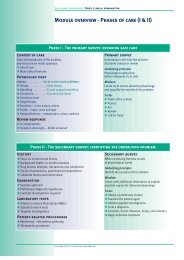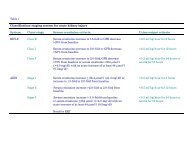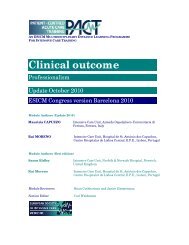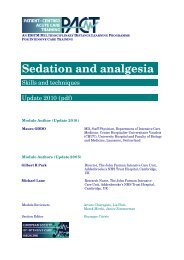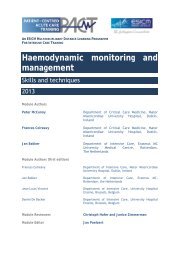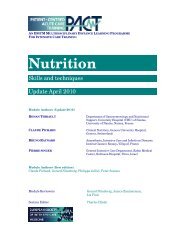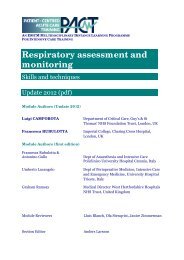Pyrexia - PACT - ESICM
Pyrexia - PACT - ESICM
Pyrexia - PACT - ESICM
You also want an ePaper? Increase the reach of your titles
YUMPU automatically turns print PDFs into web optimized ePapers that Google loves.
Task 3. Fever in specific categories of critically ill patient<br />
Q. What is the role of immunoglobulins in the treatment of toxic<br />
shock syndrome<br />
A. Their value of immunoglobulins and hyperbaric oxygen is unclear. In lifethreatening<br />
cases, the potential advantages may outweigh the current lack of positive<br />
randomised clinical trials. For further reading on this subject, see the references below.<br />
A study comparing intravenous immunoglobulins in toxic shock syndrome with<br />
historical controls, not receiving such treatment, suggested a reduced mortality rate.<br />
Kaul R, McGeer A, Norrby-Teglund A, Kotb M, Schwartz B, O'Rourke K, et al.<br />
Intravenous immunoglobulin therapy for streptococcal toxic shock<br />
syndrome – a comparative observational study. The Canadian<br />
Streptococcal Study Group. Clin Infect Dis 1999; 28(4): 800–807. PMID<br />
10825042<br />
The abdomen<br />
In patients with suspected intra-abdominal sepsis, the decision to proceed with<br />
laparotomy is hard, particularly after a prior laparotomy, with or without<br />
peritonitis. Leakage of anastomoses and ischaemia/perforation leading to intraabdominal<br />
abscesses, are most often involved, followed by postoperative<br />
cholecystitis and diverticulitis. Conversely, shock in the course of extraabdominal<br />
sepsis may occasionally result in ischaemia, necrosis and perforation<br />
of (small) bowel segments, necessitating laparotomy, resection and drainage, if<br />
the patient is considered appropriate for surgery.<br />
After a primary laparotomy, persistent fever and leukocytosis,<br />
in spite of antibiotics and in the absence of an overt extraabdominal<br />
source, may be indicative of intra-abdominal<br />
infection. Other signs that may point to (recurrent) intraabdominal<br />
sepsis and should lead to consideration of<br />
relaparotomy are respiratory failure, renal failure, ileus, wound<br />
infection, mental changes, abdominal pain, and previous<br />
contaminated surgery.<br />
Submitting a patient<br />
to<br />
diagnostic/therapeuti<br />
c relaparotomy is<br />
largely a matter of<br />
clinical judgment<br />
based on experience<br />
and may be necessary<br />
for clinical recovery<br />
On the basis of these variables, scoring systems have been developed to help<br />
decision-making for relaparotomy. Careful imaging procedures (CT scan) are<br />
helpful in guiding surgery, while laboratory tests are not. Nevertheless,<br />
laparotomy without specific indications appears diagnostic in more than half of<br />
cases of suspected intra-abdominal sepsis. The mortality risk of a negative<br />
laparotomy in the critically ill is about 15%, while unrecognised intra-abdominal<br />
sepsis may have a mortality rate exceeding 50%. A laparotomy should not be<br />
withheld in such patients when there is a high index of suspicion for intraabdominal<br />
sepsis. Most common micro-organisms include Gram-negative and<br />
Enterobacteriaceae<br />
[32]




